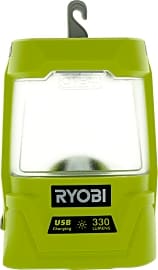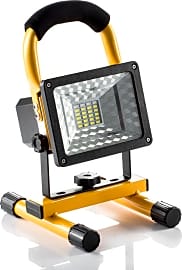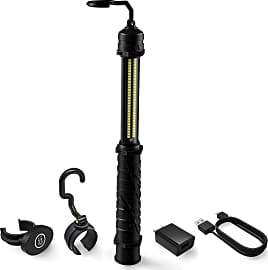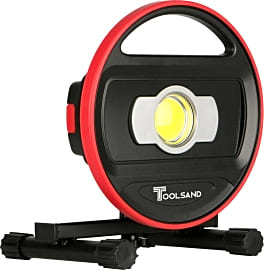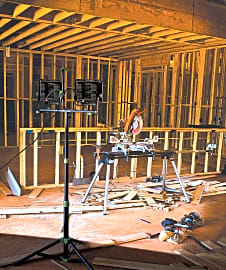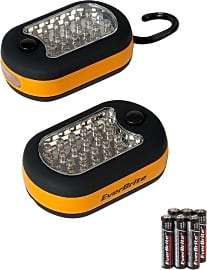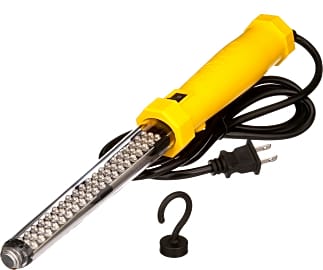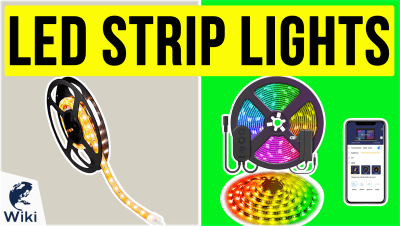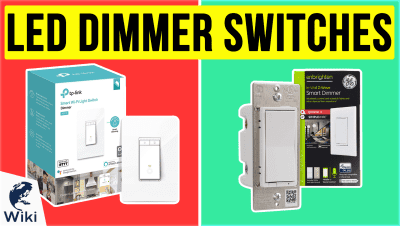The 10 Best LED Worklights

This wiki has been updated 42 times since it was first published in December of 2015. A source of quality illumination can be the difference between a safe, well-lit workspace and a dim, potentially hazardous one. Grab one of these LED lights to ensure you’re always prepared to brighten up your surroundings, whether that’s a job site, your home or your backyard. These are available in a range of sizes and designs for different types of projects and applications. When users buy our independently chosen editorial selections, we may earn commissions to help fund the Wiki.
Editor's Notes
May 29, 2019:
Though the Caterpillar Pocket is diminutive in size, it’s impressively bright when illuminated — to the surprise and delight of many of its users. Once we combined this knowledge with glowing reports about its affordability and resilient body, we decided to move it up in the list. We also gave the Ryobi P781 a bump after reviewing all the boxes it checks off: a lightweight, flexible design; the ability to charge devices via USB port; and two separate outputs modes. The only thing it seems to be missing is a handle.
The Neiko Cordless is rugged and flexible, which is why it’s useful for so many different situations, from camping to auto work. We discovered a few reports that the light may begin to flicker after a while, which contributed to our decision to drop it slightly in the rankings. We found a newer version of the PowerSmith Dual-Head available, so we swapped the old model out with the new.
In adding three Special Honors models, we tried to spray to all fields. Our selections incorporated a compact option that will fit in a pocket, a tough mid-sized unit with a rechargeable battery, and a tall tripod light with two heads.
Special Honors
Proferred Tools Some workplaces and job sites are more rugged and intense than others, but this model won’t shy away from any of them. It’s built for reliable resistance to shocks and drops, and it includes a portable folding stand for simple positioning wherever you happen to be. proferred.tools
Megapro High-Intensity Even when light conditions are normal, navigating narrow, hard-to-reach areas is a challenging task. If you often find yourself working underneath floorboards, behind drywall, or within gloomy attics, this pocket-sized option is worth considering. It even comes with batteries. megapro.net
Century Wire and Cable This line of worklights includes one dual-head model that sits on a versatile tripod base and two single-head units, one of which is powered by a rechargeable lithium ion battery. All of them are powerful and durable, with corrosion-resistant housing that remains cool to the touch. centurywire.com
Shining Light On the Situation: The LED Worklight
They could simply stop working for the day and await the following sunrise, or they could continue their efforts by the flickering light of a candle, torch, or burning lamp.
Prior to the advent of the electric light in the 19th century, once the sun had set, humans had but two options when it came to their work. They could simply stop working for the day and await the following sunrise, or they could continue their efforts by the flickering light of a candle, torch, or burning lamp.
The 20th century saw ever-greater advancements in lightbulb miniaturization, durability, and in potency of their output. And starting in the 1950s, the illumination technology that is now a part of our everyday lives first began to enjoy practical development. The first commercial LEDs produced relatively faint light suitable for use in indicator lamps such as might be found on the instrument panel of a vehicle or on a household appliance. Most early LEDs produced only red light.
Over the second half of the 1900s, LED technology advanced rapidly, and soon these diminutive devices were capable of producing not only a vast array of colors of light, but enough illumination to outclass many other types of bulb, including the traditional mainstay, the incandescent light.
And not only are LED lights powerful, but they are remarkably efficient as well, consuming much less electricity than other lights that produce comparable illumination. They also produce much less heat than other lights, making them ideal for use in close proximity to people. Thus the ascendant popularity of the LED worklight. With so many viable options now available in this category, it should be easy to find a light source that suits your working needs, no sunlight or torchlight required.
The most basic consideration to be made when choosing the right LED light for your purposes is the simple output volume you need in order to get your work done, or in other words, the brightness. If a light is not bright enough for your workspace, it's not adequate to meet your needs no matter what other features it offers. So first and foremost, you must consider lumen output. (See below for more information on output.)
Next consider the mounting or anchoring system a worklight uses. Many options come with tall stands that can help direct light about a workspace or shine down into the hood of a car, while others are designed to perch on the ground and are stable and resilient even when jostled. Still other LED lights feature powerful magnets that allow them to be placed on pipes, on a vehicle's body, and so forth.
Finally, consider the power source an LED light uses. For the campsite or the worker whose occupation brings him out into the woods or to the roadside, a battery-powered unit is a must have. For the construction professional, an AC-powered device might make much more sense, as it will never run out of energy.
A Few Words On Properties of Light
If you are committed to purchasing the right LED light for illuminating your work or hobbies, you need to have at least a rudimentary understanding of a few key aspects of illumination.
First and foremost, the term LED is an acronym for Light Emitting Diode. These elegantly simple semiconductor devices work by emitting photons, the basic light particle, when the right electrical charge is passed between the two components of a P-N junction. Light is, effectively, the welcome byproduct of a controlled electrical reaction.
So an LED light with a high lumen output and a high Kelvin rating is often the best bet for productive work after sunset.
The basic unit of measuring the brightness of a light is the lumen. Simply stated, the more lumens a light produces, the brighter that light is. As most of us remain more familiar with the traditional output ratings associated with incandescent bulbs, a quick comparison is warranted. The brightness of a standard 100-watt bulb is matched by LEDs producing around 1,600 lumens. A 75-watt bulb creates about 1,100 lumens, and a 40-watt bulb some 450 lumens.
As many LED work lights produce as much as 5,000 lumen outputs, suitable for replacing multiple large incandescent lightbulbs, their merit as effective and efficient is beyond doubt. But the type of light LEDs produce is also different than many other bulbs, and that too demands a bit of explanation.
Light color temperature is typically measured in degrees on the Kelvin scale, which abbreviated as K. Softer, "warmer" light that gives off a yellow-orange glow is rated lower on the scale, in the 2000K to 3000K range. Brighter, "cole" light is usually somewhere between 4500 and 6500K. Lights with a higher color temperature can seem harsh to some eyes, but in fact they come closer to approximating the color of sunlight, which is rated at about 5800K. So an LED light with a high lumen output and a high Kelvin rating is often the best bet for productive work after sunset.
A Bright Idea: Using LED Lights Safely
LED lighting does not get nearly as hot as more traditional illumination sources including standard incandescent and halogen bulbs. Indeed LEDs are celebrated for how cool they stay, with said cooling largely provided by a heat sink built into the base of the bulb. But don't think that LEDs won't warm up at all, for indeed they will.
Always make sure to position worklights where they will not shine into your eyes even in a tangential direction.
An intense worklight with a battery of LEDs shining in close proximity will get too hot to safely touch and can produce a fire hazard under certain circumstances. These issues are minor if understood, but potentially serious if not considered. And of course as with any electrical device, considerable caution must be used when an LED worklight is anywhere near water.
Beyond the dangers of a burn or a fire, the very brightness for which LEDs are celebrated is also a potential danger: extremely bright light can cause severe damage to the eyes, both with limited acute exposure and with chronic exposure. Always make sure to position worklights where they will not shine into your eyes even in a tangential direction.
The light source should be behind you, not to one side. And position a worklight as far away from your actual area of work as possible while still allowing for suitable illumination; the same LEDs that are harmless when viewed from across a room might be hazardous when glanced at from arm's length.



